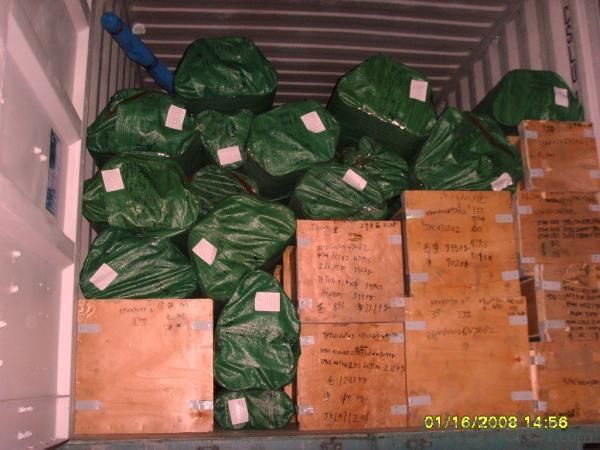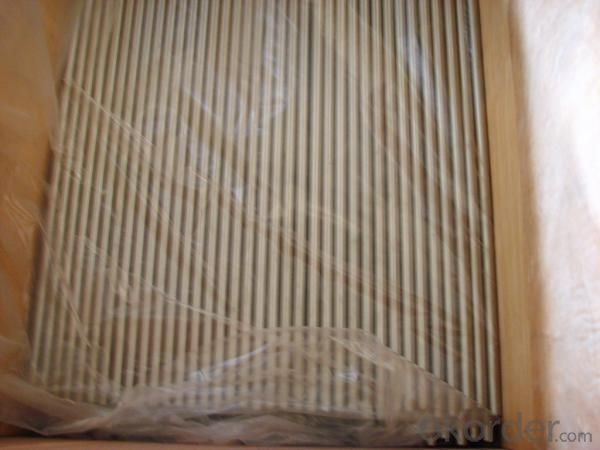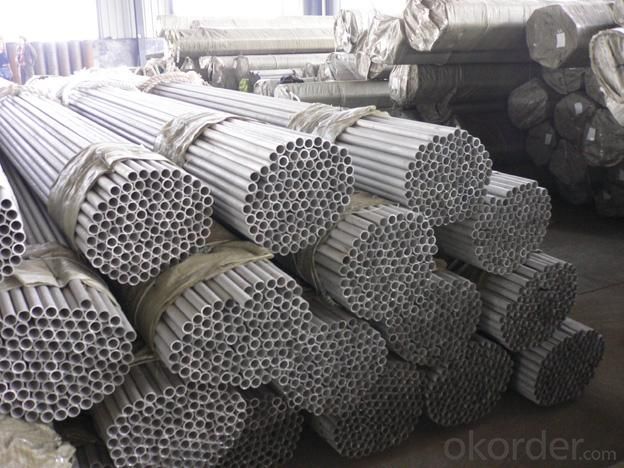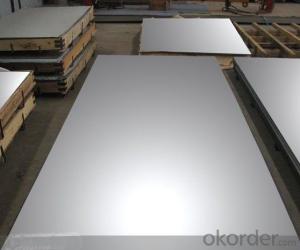Stainless Steel Seamless Pipe
- Loading Port:
- China Main Port
- Payment Terms:
- TT or LC
- Min Order Qty:
- 5 Tons m.t.
- Supply Capability:
- 500tons per month m.t./month
OKorder Service Pledge
OKorder Financial Service
You Might Also Like
Stainless steel seamless pipe
|
Standard: |
ASTM/ASME/DIN/EN/JISG/GB |
|
Dimension: |
3" - 16" x SCH10/40/80/120/160 |
|
Grade: |
304, 304L,304/304L, 316, 316L, 316/316L,316Ti,321, 321H, 310S, 347H,317L |
|
Ends: |
in plain end or bevelled ends or as customer's reqestments. |
|
Tolerance |
Thickness +20% / -12.5%. Length:+10/-0mm |
|
Price term: |
FOB,CIF,CNF,CFR etc |
|
Delivery time: |
45~60 days ,according to customer's quantity |
|
Payment: |
100% irrevocable L/C at sight, or T/T 30% deposit,or CAD |

- Q: Are stainless steel sheets suitable for chemical storage vessels?
- Indeed, stainless steel sheets prove to be a fitting option for chemical storage vessels. Renowned for its remarkable resistance to corrosion, stainless steel emerges as an optimal substance for the containment of diverse chemicals. It withstands the majority of acids, alkalis, and solvents, thereby guaranteeing the vessel's integrity and averting any potential chemical interactions or seepages. Furthermore, stainless steel boasts exceptional durability and an ability to endure elevated temperatures and pressures, rendering it an appropriate choice for an extensive array of chemical storage purposes.
- Q: What are the factors to consider when selecting the right grade of stainless steel sheet?
- There are several considerations to keep in mind when choosing the appropriate grade of stainless steel sheet. Firstly, it is crucial to understand the intended application of the sheet. Different grades of stainless steel offer varying levels of corrosion resistance, strength, and temperature resistance. Therefore, it is important to assess the specific requirements of the application, such as exposure to corrosive environments or high temperatures. Additionally, the desired appearance and finish of the sheet should be taken into account. Some grades of stainless steel are more suitable for achieving a polished or mirror-like finish, while others are better suited for a brushed or matte appearance. Certain grades may also be more resistant to scratching or showing fingerprints, which is important in applications where aesthetics are a priority. Cost is another significant factor to consider. Prices for different grades of stainless steel can vary significantly, depending on factors such as the alloying elements used and the manufacturing process. It is essential to strike a balance between the desired properties and performance of the sheet and the available budget. The ease of fabrication and welding is also a critical factor. Some grades of stainless steel are more easily machinable and formable, making them better suited for certain fabrication processes. Similarly, certain grades have better weldability, which is important in applications where welding is required. Lastly, the availability and sourcing of the selected grade should be considered. Certain grades of stainless steel may be more readily available in specific regions or from certain suppliers. Ensuring that the selected grade can be easily sourced is important to avoid delays or increased costs in the supply chain. In conclusion, when choosing the appropriate grade of stainless steel sheet, careful consideration should be given to factors such as the intended application, desired appearance, cost, ease of fabrication and welding, and availability. By evaluating these factors, one can make an informed decision and select the most suitable grade of stainless steel sheet for their specific requirements.
- Q: Are stainless steel sheets suitable for oil refineries?
- Yes, stainless steel sheets are suitable for oil refineries. Stainless steel is often chosen for its excellent resistance to corrosion, high temperature resistance, and durability. These properties make it highly suitable for the harsh conditions found in oil refineries, where the presence of corrosive chemicals, high temperatures, and constant exposure to moisture can be detrimental to other materials. Stainless steel sheets are commonly used in various applications within oil refineries, including storage tanks, pipelines, heat exchangers, and other equipment where corrosion resistance is crucial. Additionally, stainless steel sheets can be easily cleaned and maintained, which is important in maintaining the efficiency and functionality of equipment in oil refineries.
- Q: Are stainless steel sheets suitable for architectural mesh or screens?
- Yes, stainless steel sheets are indeed suitable for architectural mesh or screens. Stainless steel is a versatile and durable material that offers numerous advantages for architectural applications. It is resistant to corrosion, which is crucial for outdoor installations or areas with high humidity. This resistance ensures that the mesh or screens will maintain their structural integrity and aesthetic appeal over time. Additionally, stainless steel has a high strength-to-weight ratio, making it an ideal choice for architectural mesh or screens that require both durability and flexibility. It can be easily fabricated into different shapes and sizes, allowing for custom designs and variations. Stainless steel also offers a sleek and modern appearance, which enhances the overall aesthetic of architectural projects. Overall, stainless steel sheets are a reliable and suitable material for architectural mesh or screens due to their corrosion resistance, strength, versatility, and aesthetic appeal.
- Q: Can stainless steel sheets be formed into different shapes?
- Yes, stainless steel sheets can be formed into different shapes through processes such as bending, rolling, and stamping.
- Q: What are the different types of stainless steel alloys used for sheets?
- There are several different types of stainless steel alloys commonly used for sheets, such as austenitic stainless steel, ferritic stainless steel, martensitic stainless steel, and duplex stainless steel. Each alloy has its own unique properties and characteristics, making them suitable for various applications and environments.
- Q: What are the common sizes and thicknesses of stainless steel sheets?
- The common sizes and thicknesses of stainless steel sheets vary depending on the intended use and industry standards. However, there are some standard sizes and thicknesses that are commonly found in the market. For stainless steel sheets, the most common sizes range from 4x8 feet (1219x2438mm) to 5x10 feet (1524x3048mm). These sizes are widely available and are suitable for various applications such as construction, automotive, and fabrication. Regarding thickness, stainless steel sheets are available in a range of gauges, usually measured in inches or millimeters. The most common thicknesses for stainless steel sheets are 0.0276 inches (0.7mm), 0.0359 inches (0.91mm), 0.0478 inches (1.21mm), 0.0598 inches (1.52mm), 0.0747 inches (1.90mm), and 0.0897 inches (2.28mm). These thicknesses are frequently used in commercial and industrial applications. It is important to note that stainless steel sheets can be custom-made to meet specific requirements, including non-standard sizes and thicknesses. In such cases, it is advisable to consult with a supplier or manufacturer who can provide personalized solutions based on the specific needs of the project.
- Q: Can stainless steel sheets be used for architectural façades?
- Yes, stainless steel sheets can be used for architectural façades. Stainless steel is a durable and versatile material that offers many advantages for façade applications. It is resistant to corrosion, weathering, and staining, making it an ideal choice for exterior use. Stainless steel sheets can be fabricated into various shapes and sizes, allowing for a wide range of design options. Additionally, stainless steel can be finished in different ways, such as brushed, polished, or colored, providing further aesthetic possibilities. Its strength and rigidity also make it suitable for large-scale installations. Overall, stainless steel sheets offer durability, aesthetic appeal, and design flexibility, making them a popular choice for architectural façades.
- Q: What are the benefits of using patterned stainless steel sheets in interior design?
- There are numerous advantages to utilizing patterned stainless steel sheets in interior design. To begin, these sheets bring a distinct and contemporary aesthetic to any area. The patterns etched onto the stainless steel come in a variety of designs, ranging from geometric shapes to intricate motifs, adding a touch of elegance and visual interest to walls, ceilings, or furniture. This can enhance the overall ambiance of a room and make it truly stand out. Additionally, patterned stainless steel sheets are incredibly durable and long-lasting. Stainless steel is well-known for its strength and resistance to corrosion, making it an ideal material for interior design applications. These sheets can withstand daily wear and tear, making them suitable for high-traffic areas such as restaurants, hotels, or public spaces. Furthermore, patterned stainless steel sheets require minimal maintenance. Unlike other materials, stainless steel is easy to clean and does not require special care or regular maintenance. A simple wipe with a damp cloth or the use of mild cleaning agents is sufficient to keep the sheets looking pristine. This makes them a practical choice for interior design, especially in areas where hygiene is crucial. Moreover, patterned stainless steel sheets offer design versatility. They can be used in various applications, including wall cladding, room dividers, backsplashes, or even as decorative accents. With a wide range of patterns and finishes available, designers have the freedom to create unique and customized looks to suit any style or theme. Lastly, incorporating patterned stainless steel sheets into interior design is environmentally friendly. Stainless steel is a recyclable material, meaning it can be reused or repurposed without causing harm to the environment. By incorporating sustainable materials into interior design, we contribute to reducing waste and promoting eco-conscious practices. In conclusion, the use of patterned stainless steel sheets in interior design provides benefits such as aesthetic appeal, durability, low maintenance requirements, versatility, and environmental friendliness. These sheets offer a practical and visually pleasing solution to elevate the design of any space.
- Q: What is the maximum length of a stainless steel sheet?
- The maximum length of a stainless steel sheet can vary depending on the manufacturer and specific requirements, but it is generally available in standard sizes of up to 12 feet (3.6 meters) long. However, longer custom lengths may be available upon request.
1. Manufacturer Overview
| Location | Zhejiang, China |
| Year Established | 2005 |
| Annual Output Value | Above US$1.6 million |
| Main Markets | Europe, North America. |
| Company Certifications |
2. Manufacturer Certificates
| a) Certification Name | |
| Range | |
| Reference | |
| Validity Period |
3. Manufacturer Capability
| a) Trade Capacity | |
| Nearest Port | Shanghai |
| Export Percentage | 40% |
| No.of Employees in Trade Department | Above 30 people |
| Language Spoken: | English, Chinese |
| b) Factory Information | |
| Factory Size: | Above 5000 square meter |
| No. of Production Lines | Above 6 |
| Contract Manufacturing | OEM Service Offered |
| Product Price Range | Average |
Send your message to us
Stainless Steel Seamless Pipe
- Loading Port:
- China Main Port
- Payment Terms:
- TT or LC
- Min Order Qty:
- 5 Tons m.t.
- Supply Capability:
- 500tons per month m.t./month
OKorder Service Pledge
OKorder Financial Service
Similar products
Hot products
Hot Searches
Related keywords
































